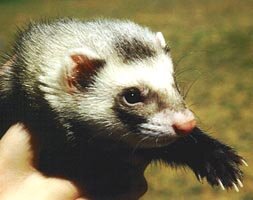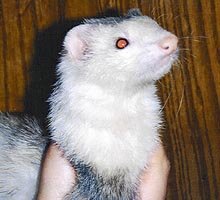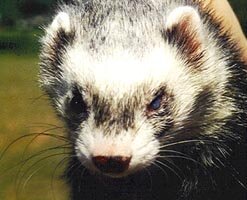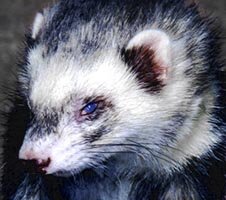-
- Note:
- These articles and images are copyrighted and may not be reprinted, re-used, reposted, copied, or otherwise distributed without permission from the author and publisher.
Disclaimer:
You should not rely on the veterinary advice or information provided on this site for diagnosis or treatment of any specific situation. Always consult your own veterinarian for specific advice concerning the medical condition or treatment of your own pet or animal.
 - Stevie has healthy, normal eyes - meaning he doesn't see too well.
-
-
-
-
-
-
-
-
-
 - Misty's eyes glow red, which is common for Blaze ferrets.
 - Captain Morgan has his eye poked out by a toddler with a fork.
 - His eye doesn't hurt anymore, but he can't see out of it at all.
|
-
- Parts of the Ferret Eye
- Your ferret’s eyes are similar to that of a human. On the outside, you see an "eyebrow" made up of eight whiskers that help ferrets sense objects that might impact the eye from above. Human eyebrows are much shorter, because we use our lashes for eye protection, and ferrets have extremely tiny lashes. At the corner of the eye is the edge of the nictitating membrane (inner eyelid). Ferrets have an outer eyelid that covers up most of the sclera (the white part of the eye), so what you see is the iris (colored part) and the pupil. The iris and pupil are usually so dark that it is difficult to tell the difference between the two.
-
- The protective covering over the iris and pupil is the cornea. Light goes through the clear cornea and the lens underneath it and shines on the back of the eye, which is the retina. Special visual receptors in the retina, called rods and cones, transmit information to the optic nerve and to the brain. This is how ferrets (and humans) see.
-
- What Does a Healthy Eye Look Like?
- Ferret eyes should be bright and shiny with no visible opaqueness (whitish areas) when held near light, or using a pen light. There should be no tearing or discharge. Areas around the eyes should be free of evidence of tearing or crusting at the corners. The inner eyelid should not be in evidence, except at the very corner of the eye. Eyes should also be even in size. Any noted problems should be checked by a veterinarian.
-
- Eye Colors
- The iris of a ferret is usually dark brown (for a sable ferret), burgundy (dark-eyed whites, blazes, or pandas), or red (albinos). On rare occasions, a ferret will have blue eyes (usually a blaze ferret). The red eyes of the albino are not really red; they are actually clear and have no pigment at all, so the red color you see is blood circulating. Similarly, the burgundy or cranberry-colored eyes of the dark-eyed white only have some pigment, so you see a combination of brown coloring and red circulating blood.
-
- Visual Stimuli
- According to noted ferret researcher Fara Shimbo, training ferrets by using visual stimuli (such as using hand signals to get your ferret to do tricks) is very frustrating, because ferrets rarely prefer to pay attention to visual stimuli. In fact, although ferrets are expert maze runners, the visible features of the maze play no part in the ferrets’ ability to learn their way around. Visible features do, however, influence how much time the ferret will spend investigating that part of the maze. If you must use a visual cue, make sure it is drastic enough to get a ferret’s attention in the first place. A ferret will pay more attention to complex visual stimuli. For example, ferrets will prefer black-and-white stripes over a solid color.
-
- Ferret Vision: How Well Do Ferrets See?
- At close range (one or two ferret lengths), your ferret sees better detail than you do. Ferrets have better visual acuity at close ranges than cats, but worse than most rodents. However, ferrets have a "blind spot" directly in front of their nose, so they will smell whatever is under their nose rather than seeing it. Additionally, at farther distances, ferrets do not see detail well at all. It is unlikely that ferrets can look up at you and see specific details of your face; they just know you have a face.
-
- It is important for ferrets interacting with each other to be able to see at close range. Ferrets often communicate with body language to you and to other ferrets. The bottle-brush tail, vibrating tails, weasel war dancing, plowing the carpet, and other visual displays are all meant to say something to others.
-
- Ferrets have "binocular" or "stereoscopic" vision. This means that ferret eyes are placed more to the sides of their heads than humans and have much better peripheral vision. However, the domesticated ferret has different binocular vision than Steppe or European polecats, or even the American Black-Footed Ferret, because domestication has changed the eye socket placement in the skull. Although ferrets can swivel their eyes to look at different objects, they don’t use their eyes independently. For the most part, ferrets look forward, and turn their heads to see things to the side, just like we do.
-
- Studies have shown that ferrets are quite variable in their ability to perceive depth. Most ferrets have little depth perception, and will happily walk off a table, bookcase, or even a cliff with no hesitation. This may be because of their inability to see how far down the floor really is. Ferret safety is an issue here: make sure to ferret-proof your home in such a way that your ferrets cannot climb up tall objects and then fall off. On the other hand, a few ferrets, like their wild cousins, are terribly afraid of heights and will scramble away from the edge of a table, or be extremely uncomfortable about riding on your shoulder unless supported by a hand.
-
- Seeing in the Dark: My Ferret’s Eyes Glow!
- Ferret eyes work best at "twilight" or at dusk and dawn. This phenomenon is probably left over from when the ferret was a wild polecat thousands of years ago. Polecats hunt their prey and are most active at dusk and dawn. Ferrets do not see well in pitch dark, and have difficulty adapting to bright light. However, their ability to see in low-light conditions is far better than that of humans.
-
- Ferrets’ eyes appear to glow in the dark. Actually, the eye does not produce light, it merely has the ability to reflect extremely low levels of light. Similar to cats and horses, ferrets’ eyes have a "tapetum lucidum" which is a reflective layer at the back of the retina that shines even the smallest amount of light back onto the rods and cones. This extra reflection helps ferrets to have more effective vision at low light levels.
-
- Ferrets’ eyes can "glow" in different colors. For example, albino ferrets’ red eyes will most often glow a bright pinkish green. Ferrets with burgundy or cranberry-colored eyes or blue-eyed ferrets glow red. Most ferrets with brown eyes glow green or yellow. On rare occasions, a ferret will have one eye that glows green and one that glows red!
-
- Another reason ferrets see well in low-light conditions is because of the shape of their pupil. Humans have a round pupil, and ferrets have a slit pupil. Slit pupils enhance edge detection and make objects more visible in low light. Cats also have a slit pupil, but a cat’s pupil is slit vertically, and a ferret’s pupil is slit horizontally. This difference is because cats hunt prey that scurry past them horizontally, and ferrets are attracted to objects that hop up and down vertically. A ball bouncing up and down is much more exciting for your ferret than for your cat! The slit pupil makes up for the nearsightedness: although your ferret can’t make out much detail at a distance, he can see movement quite well. So if you stand still, your ferret may not see you across the room, but as soon as you move, he will!
-
- Can My Ferret See Colors?
- Research on wild polecats has shown that polecats can distinguish red and blue, and can probably see yellows and greens as well. However, the evolution of the domesticated ferret has reduced the ability to see colors. Several research studies have concluded that ferrets are only able to see red; everything else is just shades of grey. This is not surprising, because the ferret is less reliant on vision than other senses, and color is not an important factor in seeing in low-light conditions. So you don’t have to worry about picking out your ferret’s favorite color for his hammock!
-
- The Life Cycle of the Ferrets’ Eyes
- The eyes of a newborn ferret are only 25% of adult size. By the time the ferret kits open their eyes at 30-38 days, eyes are still only 60% of the adult size. Interestingly, if ferret kits are handled daily from birth, their eyes open earlier. By about three months, eyes have reached full adult size. This slow development indicates that eyesight is less important to ferrets than other senses, such as smell, touch, and hearing. Reliance on other senses is good because many ferrets lose their eyesight as they become senior citizens, but get along fine anyway.
-
- Blindness and Vision Problems Ferrets
- Blind ferrets are not uncommon. Ferrets can lose their eyesight at an early age due to illness, or even medications used to treat illnesses. Ferrets can also lose eyes in accidents. Eye punctures, scratched corneas, and luxated lenses can cause your ferret to lose sight in one or both eyes. Older ferrets begin to lose their vision just like humans do, and they may become totally blind toward the end of their lives. This blindness is usually due to cataracts.
-
- Albino ferrets often suffer from being cross-eyed, thus reducing their ability to see well. Additionally, albino ferrets suffer from an abnormality that sends scrambled signals from the eye to the brain, thus disrupting binocular vision and the ability to process visual stimuli correctly. Even colored ferrets can have this albino vision abnormality, because many colored ferrets (especially cinnamons, dark-eyed whites, and pandas) have albino genes.
-
- Some ferrets are born with aphakia (no lens), microphakia (small lens), or microphthalmos (decreased eye size). Ferret with very small eyes or eyes of different sizes may have these congenital defects. These ferrets should not be bred.
-
- Despite blindness or genetic vision problems, ferrets do not seem to have much of a problem with loss of vision. Many people do not even notice that their ferret is blind. Ferrets easily learn their way around their cage and house by remembering where objects are located and the distances between them. You may only notice your ferret is blind if you buy a new piece of furniture or shut a door that has always been open. Then you might notice your ferret running into the new item or bumping the closed door. Blind ferrets in a new, unfamiliar situation will hug the edges of walls and explore with their nose and whiskers and soon learn their way around. In multiple-ferret households, a sighted ferret will often pair with a blind ferret and act as the "seeing-eye ferret" for the visually impaired one.
-
- Allergies and Eye Infections
- Does your ferret have tearing, watery eyes? A clear discharge may indicate an allergy. Ferrets have sensitive respiratory systems, and the same things that irritate ferret lungs can irritate ferret eyes. The most common cause of allergy is from the litterbox. Avoid dusty clay litters, or any litters with special added scents. Never use clumping litters. Most ferrets have an allergic reaction to cedar shavings, and some to pine shavings. If you must use wood shavings, stick to aspen. Another common cause of allergy is from deodorizers that humans use to cover up ferret odors. Sprays, rug powders, and gel-type air fresheners can cause ferret eyes to tear as well. Make sure to use odor neutralizers, not coverups, and avoid carpet powders altogether. Cigarette smoke is also a culprit for allergies. Avoid exposing your ferrets to second-hand smoke.
-
- Discharge from the eye (stickier than tears, and whitish, yellow, or green) or swollen eyes may indicate an infection. The infection may be localized to the eye, or be part of the symptoms of an infection elsewhere in the body. Flus and colds can cause these discharges. Your ferret may also have conjunctivitis, infectious keratitis (pink eye), In a worst-case scenario, pus exuding from the eyes can be a sign of distemper. Be sure your ferret has been properly vaccinated against distemper. If you see a pus-like discharge from your ferret’s eyes, and you have removed all allergens, contact your veterinarian. Your ferret may need antibiotics or special eye drops.
-
- Eye Injuries
- Watery eyes can also be due to foreign objects in the eye (dust, a piece of carpet lint, or a strand of fur, for example). In this case, your ferret may be blinking or trying to keep one eye closed. If you see something in your ferret’s eye, try and flush it out with a mild saline solution made for rinsing soft contact lenses. Do not poke your finger or any other object into the eye in an attempt to remove the item. Finally, watery eyes can indicate a mild injury to the eye, such as a corneal scratch from an accident while playing or a foreign object. Your veterinarian can prescribe eye drops or ointment that can soothe the irritation and help speed healing.
-
- Ferrets can sometimes experience more serious eye injuries. These can result in cataracts and luxated lenses (which are explained further below). Eyes can also be punctured accidentally from protruding cage wires, a baseboard nail that sticks out, or any other sharp object. Conscientious ferret-proofing to make sure your home is safe is vital for your ferret. However, accidents can happen. Ferrets can have their eyes lacerated while playing with a cat. I own a ferret who had his eye punctured by a toddler swinging a fork. When eyes are cut or punctured, the fluid inside the eyeball will evacuate. In some cases, the eye will heal, but the fluid will not "grow back." The eye will be much smaller, and look whitish from the scar tissue and nictitating membrane that becomes more visible. In other cases, the eye must be removed, and your veterinarian will stitch the eyelid shut over the socket.
-
- Other Eye Diseases and Problems
- Cataracts are a common problem in ferrets. When the lens of the eye becomes opaque, it will let some light in, but not visual images. Cataracts are common in older ferrets due to aging, but juvenile cataracts can occur in kits as well. Juvenile cataracts is most often hereditary. Some eye injuries can cause the lens to form white scar tissue, thus forming a cataract as well. Exposure to certain drugs, or oxygen toxicity during anesthesia can also result in cataracts.
- Another problem ferrets can experience is a luxated lens. This happens when the lens of the eye shifts into an abnormal position. A blow to the eye may have damaged the ligaments holding the lens in place. The dislocated lens may become opaque. Options are surgery to replace the lens (usually quite expensive), eye drops to relieve pressure, or removal of the eye.
-
- Ferrets can also experience the growth of other tissues in and around the eye. Pigmentary keratitis occurs when spots of pigment are deposited in the eye, eventually leading to blindness. The cause of these pigment deposits is unknown. Intraocular neoplasms (tumors within the eye) have been reported in ferrets; some of these have been carcinomas. More common are tumors around the eye, such as mast cell tumors and sebaceous gland tumors on the eyelids.
-
- Retina problems can also occur in ferrets. Ferrets have been reported to experience glaucoma, which is a change in the fluid pressure inside the eye. One common symptom of glaucoma is a larger or protruding eye. The cornea may also become opaque, and lesions of the retina occur. Retinal lesions can also be from your ferret experiencing diseases such as canine distemper, toxoplasmosis, and coccidia. Nutrition can also play a role in eye health. Deficiencies in vitamin A or taurine can lead to retinal degeneration, as can irradiation, anemia, and toxins that have been ingested (bracken fern, for example).
-
- A Final Note on Eyes
- Your ferrets’ eyes may seem to be the most expressive part of your ferret. Human beings are drawn to the eyes of others. Remember, though, that ferrets are less concerned about what they see and more focused on what they smell, feel, and hear. When you gaze into those adorable eyes, also look for signs of health problems, as the eyes are an indicator of how your ferret feels. Hopefully, your ferrets will have bright and shiny eyes, and show you just how happy and healthy they really are!
|